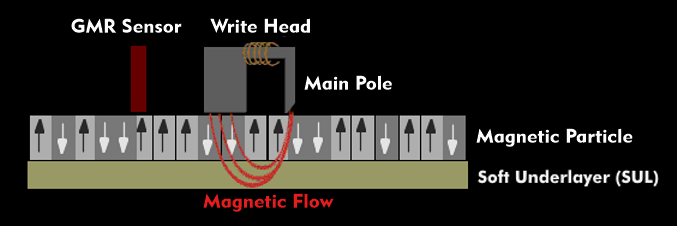perpendicular magnetic recording (PMR)
In the classic magnetization process of hard disks, the data is stored on the storage medium in the longitudinal direction. The read/write head aligns the magnetic particles horizontally on the magnetic layer. This process is known as Longitudinal Magnetic Recording( LMR). The storage density depends on the magnetic particle size.
The situation is different with perpendicular recording. If, on the other hand, the magnetic particles are aligned perpendicular to the hard disk surface, the storage density can be increased considerably. However, this requires that the magnetic particles are magnetized perpendicularly. This is achieved by focusing the magnetic flux so that it penetrates deeper into the magnetic layer. For this purpose, the magnetic poles of the write head are modified and the main pole is made particularly narrow, resulting in an increased magnetic flux in this pole. The rear pole, on the other hand, is wide so that the magnetic field in it is weakened and the data written by the main pole is not erased by the rear pole.
Since the storage density in perpendicular magnetic recording (PMR) is higher than in conventional longitudinal recording, the data is read with a GMR sensor. A further increase in storage density is possible with Shingled Magnetic Recording( SMR), which makes optimum use of the tracks.

